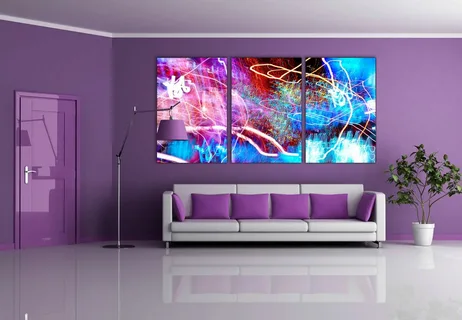
In the vast realm of artistic expression, wall painting stands as a testament to humanity’s innate desire to adorn and communicate through visual storytelling. From the ancient cave paintings of Lascaux to the contemporary murals adorning city streets, wall painting has evolved into a multifaceted medium that transcends time, culture, and geography. In this exploration, we delve into the rich tapestry of wall painting, tracing its historical origins, exploring its diverse techniques, and celebrating its enduring significance in the modern world.
Ancient Origins: The Dawn of Visual Expression
The roots of Wall Painting stretch back to the earliest civilizations, where our ancestors adorned cave walls with vivid depictions of their lives, rituals, and beliefs. These ancient cave paintings, discovered in locations such as Altamira in Spain and Chauvet in France, provide a fascinating glimpse into the artistic sensibilities and spiritual beliefs of prehistoric humans. Through their intricate compositions and vibrant colors, these ancient artworks serve as a testament to the universal human impulse to create and communicate through imagery.
As civilizations emerged and flourished, wall painting became a prevalent form of artistic expression across cultures and continents. In ancient Egypt, elaborate murals adorned the walls of temples and tombs, depicting scenes from mythology, religious rituals, and daily life. Similarly, the frescoes of ancient Greece and Rome depicted mythological narratives, historical events, and idealized portraits, showcasing the skill and creativity of artists in capturing the essence of the human experience.
The Renaissance Revival: A Golden Age of Artistic Innovation
The Renaissance period witnessed a resurgence of interest in classical art and culture, leading to a renaissance in wall painting across Europe. In Italy, the birthplace of the Renaissance, master artists such as Leonardo da Vinci, Michelangelo, and Raphael created some of the most iconic and enduring works of wall painting in history. Their masterpieces, characterized by technical brilliance, emotional depth, and aesthetic harmony, continue to inspire awe and admiration to this day.
Michelangelo’s breathtaking frescoes in the Sistine Chapel, including the iconic “Creation of Adam” and “The Last Judgment,” stand as monumental achievements of Renaissance art, showcasing the artist’s mastery of form, composition, and narrative. Raphael’s exquisite frescoes in the Vatican Palace, notably the “School of Athens,” exemplify the idealized beauty and intellectual sophistication of Renaissance humanism. Meanwhile, Leonardo da Vinci’s enigmatic mural, “The Last Supper,” captivates viewers with its emotional intensity and psychological complexity, offering a profound meditation on faith, betrayal, and redemption.
Techniques and Traditions: The Artisan’s Craft and Creative Ingenuity
The art of wall painting encompasses a diverse array of techniques, each requiring skill, patience, and imagination. One of the oldest and most enduring methods is fresco painting, where pigments are applied onto wet plaster, allowing the colors to become an integral part of the wall surface. This technique, perfected by artists throughout history, produces vibrant and long-lasting artworks that withstand the test of time.
In addition to fresco painting, artists employ a variety of other techniques to create wall paintings on dry surfaces. Mural painting, which involves the application of paint directly onto dry walls, offers greater flexibility and immediacy in artistic expression. From the intricate brushwork of Renaissance masters to the bold strokes of contemporary street artists, muralists continue to push the boundaries of creativity and innovation, exploring diverse styles, themes, and mediums.
The Contemporary Canvas: A Platform for Expression and Engagement
In recent decades, wall painting has experienced a resurgence of popularity and relevance, fueled by the rise of street art movements and urban culture. Cities around the world have become vibrant canvases for graffiti artists and muralists, who use their art to challenge norms, provoke thought, and inspire change. From the gritty streets of New York City to the bustling neighborhoods of São Paulo and Berlin, street art has become a powerful form of social commentary and cultural expression, reflecting the diverse voices and experiences of contemporary society.
In addition to its role in urban landscapes, wall painting has found new avenues of expression in galleries, museums, and public spaces. Artists like Banksy, Shepard Fairey, and JR have gained international acclaim for their provocative and thought-provoking works, blurring the lines between fine art and popular culture, and challenging the conventions of the art world. Their art serves as a catalyst for dialogue and debate, addressing pressing issues such as social justice, environmental conservation, and cultural identity.
The Transformative Power of Art: Inspiring Connection and Reflection
Beyond its aesthetic appeal, Wall Painting has the power to transform spaces, evoke emotions, and inspire reflection. In neighborhoods facing economic hardship or social inequality, murals can serve as symbols of resilience, empowerment, and hope, bringing beauty and inspiration to overlooked or marginalized communities. Community-led mural projects, such as those organized by the Mural Arts Program in Philadelphia or the Street Art Foundation in London, bring together artists, residents, and stakeholders to beautify neighborhoods, celebrate local history and culture, and promote social cohesion.
Moreover, wall painting has the ability to raise awareness about pressing issues such as environmental conservation, racial justice, and human rights. Artists use their platforms to amplify marginalized voices, challenge stereotypes, and advocate for social justice causes, turning walls into canvases for activism and advocacy, and inspiring viewers to reflect on their own beliefs, values, and actions.
Conclusion: Celebrating the Legacy and Continued Relevance of Wall Painting
In conclusion, wall painting remains a dynamic and influential form of artistic expression that continues to captivate and inspire audiences around the world. From its humble beginnings in ancient caves to its contemporary manifestations in urban landscapes, the art of painting on walls reflects the diversity, ingenuity, and resilience of the human spirit. As we celebrate the legacy and continued relevance of wall painting, let us embrace its power to unite communities, provoke thought, and inspire positive change in the world.